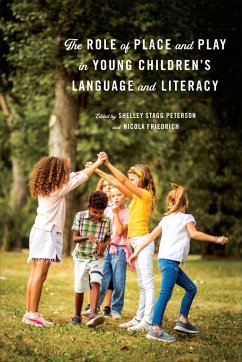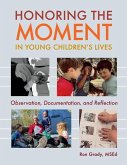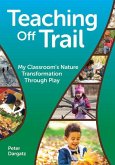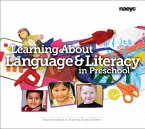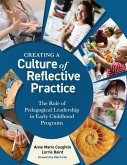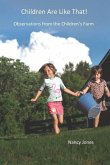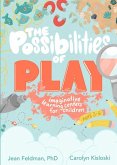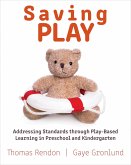The Role of Place and Play in Young Children's Language and Literacy
Herausgeber: Stagg Peterson, Shelley; Friedrich, Nicola
The Role of Place and Play in Young Children's Language and Literacy
Herausgeber: Stagg Peterson, Shelley; Friedrich, Nicola
- Broschiertes Buch
- Merkliste
- Auf die Merkliste
- Bewerten Bewerten
- Teilen
- Produkt teilen
- Produkterinnerung
- Produkterinnerung
This book brings notions of play and place as cultural constructions into conversations about language and literacy.
Andere Kunden interessierten sich auch für
![Honoring the Moment in Young Children's Lives Honoring the Moment in Young Children's Lives]() Ron GradyHonoring the Moment in Young Children's Lives28,99 €
Ron GradyHonoring the Moment in Young Children's Lives28,99 €![Teaching Off Trail: My Classroom's Nature Transformation Through Play Teaching Off Trail: My Classroom's Nature Transformation Through Play]() Peter DargatzTeaching Off Trail: My Classroom's Nature Transformation Through Play26,99 €
Peter DargatzTeaching Off Trail: My Classroom's Nature Transformation Through Play26,99 €![Learning about Language and Literacy in Preschool Learning about Language and Literacy in Preschool]() Learning about Language and Literacy in Preschool27,99 €
Learning about Language and Literacy in Preschool27,99 €![Creating a Culture of Reflective Practice: The Role of Pedagogical Leadership in Early Childhood Programs Creating a Culture of Reflective Practice: The Role of Pedagogical Leadership in Early Childhood Programs]() Anne Marie CoughlinCreating a Culture of Reflective Practice: The Role of Pedagogical Leadership in Early Childhood Programs36,99 €
Anne Marie CoughlinCreating a Culture of Reflective Practice: The Role of Pedagogical Leadership in Early Childhood Programs36,99 €![Children Are LIke That!: Observations from the Children's Farm Children Are LIke That!: Observations from the Children's Farm]() Nancy JonesChildren Are LIke That!: Observations from the Children's Farm17,99 €
Nancy JonesChildren Are LIke That!: Observations from the Children's Farm17,99 €![The Possibilities of Play The Possibilities of Play]() FeldmanThe Possibilities of Play30,99 €
FeldmanThe Possibilities of Play30,99 €![Saving Play: Addressing Standards Through Play-Based Learning in Preschool and Kindergarten Saving Play: Addressing Standards Through Play-Based Learning in Preschool and Kindergarten]() Gaye GronlundSaving Play: Addressing Standards Through Play-Based Learning in Preschool and Kindergarten36,99 €
Gaye GronlundSaving Play: Addressing Standards Through Play-Based Learning in Preschool and Kindergarten36,99 €-
-
-
This book brings notions of play and place as cultural constructions into conversations about language and literacy.
Hinweis: Dieser Artikel kann nur an eine deutsche Lieferadresse ausgeliefert werden.
Hinweis: Dieser Artikel kann nur an eine deutsche Lieferadresse ausgeliefert werden.
Produktdetails
- Produktdetails
- Verlag: University of Toronto Press
- Seitenzahl: 282
- Erscheinungstermin: 31. März 2022
- Englisch
- Abmessung: 226mm x 150mm x 20mm
- Gewicht: 440g
- ISBN-13: 9781487529222
- ISBN-10: 1487529228
- Artikelnr.: 61383009
- Herstellerkennzeichnung
- Libri GmbH
- Europaallee 1
- 36244 Bad Hersfeld
- gpsr@libri.de
- Verlag: University of Toronto Press
- Seitenzahl: 282
- Erscheinungstermin: 31. März 2022
- Englisch
- Abmessung: 226mm x 150mm x 20mm
- Gewicht: 440g
- ISBN-13: 9781487529222
- ISBN-10: 1487529228
- Artikelnr.: 61383009
- Herstellerkennzeichnung
- Libri GmbH
- Europaallee 1
- 36244 Bad Hersfeld
- gpsr@libri.de
Edited by Shelley Stagg Peterson and Nicola Friedrich
List of Figures
1. Introduction: Playce-Based Language and Literacy Learning in Early
Childhood
Shelley Stagg Peterson and Nicola Friedrich
2. Valuing Rural and Indigenous Social Practices: Play as Placed Learning
in Kindergarten Classrooms
Karen Eppley, Shelley Stagg Peterson, and Denise Heppner
3. Seven Directions Early Learning for Indigenous Land Literacy Wisdom
Sharla Mskokii Peltier
4. Sámi Children’s Language Use, Play, and the Outdoors Through Teachers’
Lens
Kristina Belancic
5. Young Children Exploring Identities, Languages, and Cultures in a
Multicultural Place
Maria Cooper and Helen Hedges
6. Placing the Child’s Hands on the Land: Conceptualizing, Creating, and
Implementing Land-Based Teachings in a Play Space
Lori Huston and Stephanie Michano-Drover
7. Negotiating a Place to Belong in an Aotearoa New Zealand Playgroup
Mary M. Jacobs
8. The Importance of the Land, Language, Culture, Identity, and Learning in
Relation for Indigenous Children
Jeffrey Wood
9. If Writing Floats "on a Sea of Talk," How Best to Harness the Waves and
Currents of Place and Play?
Judy M. Parr
10. Scaffolding Community Literacy Practices in Kindergarten Classrooms
Nicola Friedrich
11. Children’s Engagement and Inquiry in Outdoors Contexts as Play- and
Place-Based Learning
Gisela Wajskop
12. Enriching Learning with the Richness Around Us
Christine Portier
13. Exploring Urban Place-Based Play as a Stimulus for "Language in Action"
and "Language as Reflection"
Janet Scull and Kim O’Grady
14. The Key Role of the Educator as a Conversational Partner in Play- and
Place-Based Learning
Janice Greenberg and Sharon Walker
15. Language Learning in the Garden: Discoveries from a Collaboration in a
North-Central Saskatchewan Indigenous Community
Laureen J. McIntyre, Laurie-ann M. Hellsten, and Tyler Bergen
16. Conclusion: Questions and Implications Arising from Playce-Based
Learning in Communities across Four Continents
Shelley Stagg Peterson
17. Places and Players: An Afterword
Michael Corbett
Contributors
Index
1. Introduction: Playce-Based Language and Literacy Learning in Early
Childhood
Shelley Stagg Peterson and Nicola Friedrich
2. Valuing Rural and Indigenous Social Practices: Play as Placed Learning
in Kindergarten Classrooms
Karen Eppley, Shelley Stagg Peterson, and Denise Heppner
3. Seven Directions Early Learning for Indigenous Land Literacy Wisdom
Sharla Mskokii Peltier
4. Sámi Children’s Language Use, Play, and the Outdoors Through Teachers’
Lens
Kristina Belancic
5. Young Children Exploring Identities, Languages, and Cultures in a
Multicultural Place
Maria Cooper and Helen Hedges
6. Placing the Child’s Hands on the Land: Conceptualizing, Creating, and
Implementing Land-Based Teachings in a Play Space
Lori Huston and Stephanie Michano-Drover
7. Negotiating a Place to Belong in an Aotearoa New Zealand Playgroup
Mary M. Jacobs
8. The Importance of the Land, Language, Culture, Identity, and Learning in
Relation for Indigenous Children
Jeffrey Wood
9. If Writing Floats "on a Sea of Talk," How Best to Harness the Waves and
Currents of Place and Play?
Judy M. Parr
10. Scaffolding Community Literacy Practices in Kindergarten Classrooms
Nicola Friedrich
11. Children’s Engagement and Inquiry in Outdoors Contexts as Play- and
Place-Based Learning
Gisela Wajskop
12. Enriching Learning with the Richness Around Us
Christine Portier
13. Exploring Urban Place-Based Play as a Stimulus for "Language in Action"
and "Language as Reflection"
Janet Scull and Kim O’Grady
14. The Key Role of the Educator as a Conversational Partner in Play- and
Place-Based Learning
Janice Greenberg and Sharon Walker
15. Language Learning in the Garden: Discoveries from a Collaboration in a
North-Central Saskatchewan Indigenous Community
Laureen J. McIntyre, Laurie-ann M. Hellsten, and Tyler Bergen
16. Conclusion: Questions and Implications Arising from Playce-Based
Learning in Communities across Four Continents
Shelley Stagg Peterson
17. Places and Players: An Afterword
Michael Corbett
Contributors
Index
List of Figures
1. Introduction: Playce-Based Language and Literacy Learning in Early
Childhood
Shelley Stagg Peterson and Nicola Friedrich
2. Valuing Rural and Indigenous Social Practices: Play as Placed Learning
in Kindergarten Classrooms
Karen Eppley, Shelley Stagg Peterson, and Denise Heppner
3. Seven Directions Early Learning for Indigenous Land Literacy Wisdom
Sharla Mskokii Peltier
4. Sámi Children’s Language Use, Play, and the Outdoors Through Teachers’
Lens
Kristina Belancic
5. Young Children Exploring Identities, Languages, and Cultures in a
Multicultural Place
Maria Cooper and Helen Hedges
6. Placing the Child’s Hands on the Land: Conceptualizing, Creating, and
Implementing Land-Based Teachings in a Play Space
Lori Huston and Stephanie Michano-Drover
7. Negotiating a Place to Belong in an Aotearoa New Zealand Playgroup
Mary M. Jacobs
8. The Importance of the Land, Language, Culture, Identity, and Learning in
Relation for Indigenous Children
Jeffrey Wood
9. If Writing Floats "on a Sea of Talk," How Best to Harness the Waves and
Currents of Place and Play?
Judy M. Parr
10. Scaffolding Community Literacy Practices in Kindergarten Classrooms
Nicola Friedrich
11. Children’s Engagement and Inquiry in Outdoors Contexts as Play- and
Place-Based Learning
Gisela Wajskop
12. Enriching Learning with the Richness Around Us
Christine Portier
13. Exploring Urban Place-Based Play as a Stimulus for "Language in Action"
and "Language as Reflection"
Janet Scull and Kim O’Grady
14. The Key Role of the Educator as a Conversational Partner in Play- and
Place-Based Learning
Janice Greenberg and Sharon Walker
15. Language Learning in the Garden: Discoveries from a Collaboration in a
North-Central Saskatchewan Indigenous Community
Laureen J. McIntyre, Laurie-ann M. Hellsten, and Tyler Bergen
16. Conclusion: Questions and Implications Arising from Playce-Based
Learning in Communities across Four Continents
Shelley Stagg Peterson
17. Places and Players: An Afterword
Michael Corbett
Contributors
Index
1. Introduction: Playce-Based Language and Literacy Learning in Early
Childhood
Shelley Stagg Peterson and Nicola Friedrich
2. Valuing Rural and Indigenous Social Practices: Play as Placed Learning
in Kindergarten Classrooms
Karen Eppley, Shelley Stagg Peterson, and Denise Heppner
3. Seven Directions Early Learning for Indigenous Land Literacy Wisdom
Sharla Mskokii Peltier
4. Sámi Children’s Language Use, Play, and the Outdoors Through Teachers’
Lens
Kristina Belancic
5. Young Children Exploring Identities, Languages, and Cultures in a
Multicultural Place
Maria Cooper and Helen Hedges
6. Placing the Child’s Hands on the Land: Conceptualizing, Creating, and
Implementing Land-Based Teachings in a Play Space
Lori Huston and Stephanie Michano-Drover
7. Negotiating a Place to Belong in an Aotearoa New Zealand Playgroup
Mary M. Jacobs
8. The Importance of the Land, Language, Culture, Identity, and Learning in
Relation for Indigenous Children
Jeffrey Wood
9. If Writing Floats "on a Sea of Talk," How Best to Harness the Waves and
Currents of Place and Play?
Judy M. Parr
10. Scaffolding Community Literacy Practices in Kindergarten Classrooms
Nicola Friedrich
11. Children’s Engagement and Inquiry in Outdoors Contexts as Play- and
Place-Based Learning
Gisela Wajskop
12. Enriching Learning with the Richness Around Us
Christine Portier
13. Exploring Urban Place-Based Play as a Stimulus for "Language in Action"
and "Language as Reflection"
Janet Scull and Kim O’Grady
14. The Key Role of the Educator as a Conversational Partner in Play- and
Place-Based Learning
Janice Greenberg and Sharon Walker
15. Language Learning in the Garden: Discoveries from a Collaboration in a
North-Central Saskatchewan Indigenous Community
Laureen J. McIntyre, Laurie-ann M. Hellsten, and Tyler Bergen
16. Conclusion: Questions and Implications Arising from Playce-Based
Learning in Communities across Four Continents
Shelley Stagg Peterson
17. Places and Players: An Afterword
Michael Corbett
Contributors
Index

